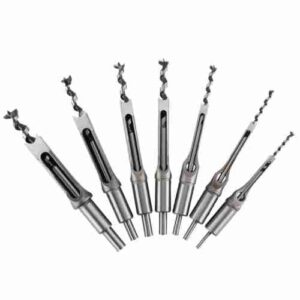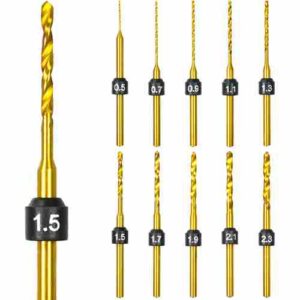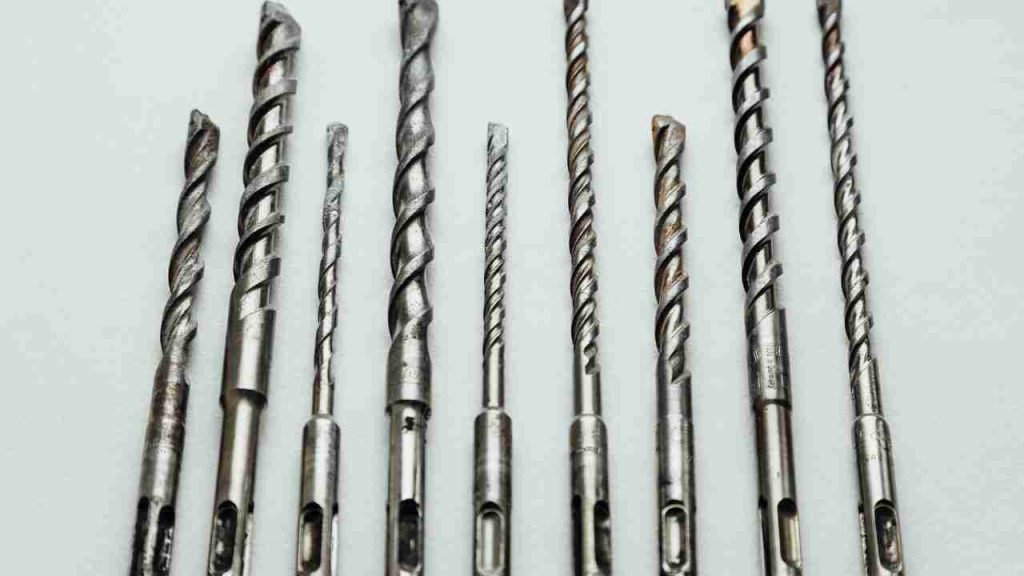Are you tired of using a hand drill to produce accurate holes in your DIY projects? A drill press may be the solution if you want to drill holes more accurately and efficiently. But what if you want to use square drill bits in a drill press? Can they do the job?
Because of its capacity to create square-shaped holes, square drill bits are becoming more popular in the woodworking and metalworking communities. Let’s see whether your drill press can handle these unusual bits! In this post, we’ll look at whether square drill bits can be used in a drill press, the benefits of utilizing a drill press, and how to use a square drill bit in a drill press.
 What is a square drill bit?
What is a square drill bit?
A square drill bit is a cutting tool to make square-shaped holes in wood, metal, and plastic materials. Unlike standard drill bits that make round holes, square drill bits feature a square-shaped cutting edge that enables them to create precise and accurate square-shaped holes.
These bits are available in various diameters and are usually constructed of high-speed steel, carbide, or cobalt. Square drill bits are often used in woodworking projects to make mortises or square holes for joinery and in metalworking applications to make square-shaped holes for bolts or other fasteners.
Different types of square drill bits:
- Standard Square Drill Bits: The most common kind of square drill bit, having a flat cutting edge that forms a square-shaped hole. They come in various sizes, from small bits for delicate work to bigger ones for heavier-duty jobs.
- Mortising Chisels: Mortising chisels are square drill bits intended exclusively for making mortises in woodworking. They feature a long, straight shank with a square-shaped point for making square holes for joinery.
- Hollow Chisels: Like mortising chisels, they feature a hollow core that enables them to extract wood or other material as they cut. In woodworking operations, they are typically used to make mortises and other square-shaped holes.
- Auger Bits are square drill bits having a helical cutting edge that can drill deep, square-shaped holes in wood or other materials. They are often used in woodworking and timber frame applications.
- Corner Chisels: Corner chisels are specialized square drill bits used in woodworking tasks to make square corners. They feature a tiny cutting edge for removing material from the corners of a square hole.
- Spade Bits: The spade bit is another square drill bit used to make square holes in wood. They feature a flat, paddle-shaped cutting edge that swiftly and effectively removes material.
Can square drill bits be used in a drill press?
Yes, square drill bits can be used in a drill press. However, the sort of drill press you have will determine this. You will need a drill press that can hold square drill bits to utilize them. Some drill presses have a keyed chuck that only accepts round drill bits, while others have a keyless chuck that accepts a wide range of shapes and sizes, including square drill bits.
When utilizing square drill bits in a drill press, it’s critical to use the correct size for the work and keep the bit securely in the chuck. If the bit is not correctly attached, it might slide or wobble, resulting in a badly drilled hole or even damage the workpiece or drill press.
 Differences between a square drill bit and a regular drill bit:
Differences between a square drill bit and a regular drill bit:
- Cutting Edge Shape: A square drill bit’s cutting edge is square, while a conventional drill bit’s cutting edge is circular. Square drill bits may therefore generate square-shaped holes, while ordinary drill bits can only create round holes.
- Square drill bits are intended to make square-shaped holes, while standard drill bits are intended to create circular holes. Regular drill bits are used for various tasks, from drilling holes in walls to producing holes in metal and plastic. Square drill bits are usually used in woodworking and metalworking projects, while square drill bits are commonly used in woodworking and metalworking projects.
- Square drill bits are offered in a smaller size range than conventional drill bits. They are commonly available in diameters ranging from 1/4 inch to 1 inch, while ordinary drill bits range from 1/16 inch to more than 1 inch.
- Square drill bits are often manufactured of higher-quality materials than standard drill bits, such as high-speed steel, cobalt, or carbide. This is because square drill bits are meant for more difficult drilling tasks, such as drilling through thick metal or hardwoods.
How do you use a square drill bit in a drill press?
- Choose the best square drill bit for the project. Check that the bit is the right size and kind for your drilling material.
- Place the drill bit firmly in the drill press chuck. If the chuck has no key, insert the bit and tighten it by hand. Insert the bit into the chuck and tighten it tightly with the key if it has one.
- The drill press’s speed should be adjusted depending on the material being drilled and the size of the bit. For suggested speed settings, see the manufacturer’s instructions.
- Place the workpiece on the drill press table and firmly clamp it.
- Drop the drill bit onto the workpiece while ensuring it is perpendicular to the surface. Switch on the drill press and begin drilling slowly and steadily.
- Apply uniform and consistent pressure to the drill press handle, careful not to drive the bit through the material.
- Drill until the hole reaches the required depth. If you need to drill a square hole, move the workpiece and drill bit to produce the next side of the square, then continue the drilling operation until all sides are complete.
- After drilling, turn off the drill press and remove the workpiece and square drill bit.
Precautions and safety tips:
- While operating a drill press with a square drill bit, it is essential to observe the following safety guidelines and precautions:
- Use adequate safety equipment, including eye and hearing protection, if required.
- Keep your hands and loose clothes away from the drill press’s working components.
- Use the correct size and kind of square drill bit for the project, then secure it in the chuck.
- The drill press’s speed should be adjusted depending on the material being drilled and the size of the bit.
- Before drilling, ensure the workpiece is properly attached to the drill press table.
- To hold tiny or oddly shaped workpieces, use a clamp or vise.
- Using a supporting board avoids tear-out when drilling into wood or other materials.
- Avoid forcing the bit through the material. Let the drill bit operate at a consistent and uniform speed.
- If required, use coolant or lubrication to avoid overheating and extend the life of the drill bit.
- Maintain the drill press and workspace clean and clutter-free.
Frequently Asked Questions (FAQs)
1. Can I use square drill bits with any drill press?
You can use square drill bits with a drill press that has a chuck that can accommodate square bits. Some drill presses have a keyed chuck that only accepts round drill bits, while others have a keyless chuck that accepts a wide range of shapes and sizes, including square drill bits.
2. Can I use square drill bits with a hand-held drill?
While it is possible to use square drill bits with a hand-held drill, it is not recommended due to the lack of precision and stability compared to a drill press. Using a drill press ensures better accuracy, control, and efficiency when drilling square holes.
3. What are the primary applications of square drill bits?
Square drill bits are mainly used in woodworking and metalworking projects that require square-shaped holes, such as mortises for joinery or square holes for bolts and other fasteners.
4. How do I choose the right size square drill bit for my project?
To choose the right size square drill bit, first determine the size of the square hole you need to create. Then, select a square drill bit with a cutting edge that matches the desired hole size. Ensure that the bit is the correct type for the material you are drilling.
5. Can I use a square drill bit to create round holes?
Square drill bits are designed specifically for creating square-shaped holes and are not suitable for creating round holes. To drill round holes, use a standard round drill bit.
6. How do I maintain my square drill bits?
To maintain your square drill bits, clean them after each use and store them in a dry, cool place. Regularly inspect them for signs of wear or damage, and sharpen or replace them as needed. Lubricate the bit with cutting oil or coolant when drilling through metal to prevent overheating and prolong the life of the drill bit.
7. Are square drill bits more expensive than regular drill bits?
Square drill bits are often made from higher-quality materials, such as high-speed steel, carbide, or cobalt, and may be more expensive than regular drill bits. However, the increased durability and precision of square drill bits can make them a worthwhile investment for specific projects that require square-shaped holes.
Final words:
With a drill press, square drill bits may generate precise and accurate square-shaped holes in various materials. Nonetheless, it is critical to utilize the correct size and a bit and ensure that it is properly held in the chuck.
In addition, to avoid harm or damage to the workpiece or the drill press, adjust the speed setting on the drill press depending on the material and bit size, and follow applicable safety recommendations.

Utilizing a drill press with a square drill bit has several benefits over using a hand-held drill, such as enhanced precision, accuracy, and efficiency. You may manufacture professional-quality square-shaped holes in your woodworking and metalworking projects by following the techniques in this article and taking the necessary safety measures.
- Where are WEN drill presses made? - April 2, 2023
- Where are Rikon drill presses made? - April 1, 2023
- Where are Powermatic drill presses made? - April 1, 2023






